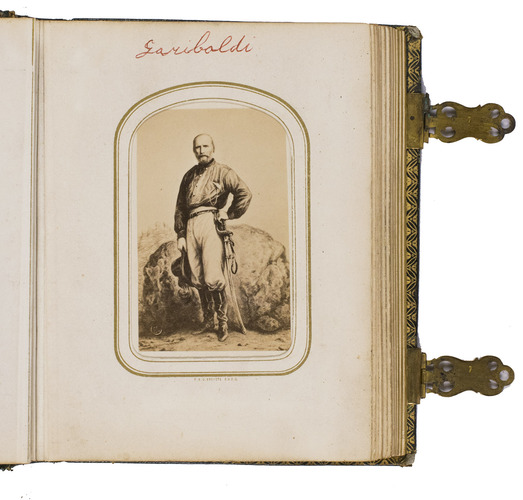PHOTOGRAPHY - CARTE DE VISITE - JAPANESE EMBASSY - EUROPEAN ROYALTY].
[Carte de visite album showing members of the first Japanese embassy to Europe in 1862, European royalty, and other prominent 19th-century figures].
[France?], [various photographers], 1850s-1860s. Album: ca. 15 x 12 cm; cartes de visite: ca. 10 x 6.5 cm. With 26 carte de visite images and photos showing European royalty and other prominent figures, including 3 reproductions of drawings in colour, and 3 (landscape) views. Most of the photos are albumen prints. All images are mounted on thick paper to make the carte de visite and are inserted into the specially made leaves of the album, each leaf holding 2 images and framing them in a gold-printed triple fillet frame. Contemporary, richly blind-tooled green leather with ornamental brass clasps, gold-tooled board edges and turn-ins, white watered silk endpapers, gilt edges. [1 blank], [15], [1 blank] ll.
€ 8,500
Original ornate "carte de visite" album containing 26 carte de visite photos and illustrations of 2 members of the first Japanese embassy to Europe in 1862, European Royalty and other prominent figures. The "cartes de visite" in the present album are a combination of original albumen prints and reproductions of engravings and other drawings of people and places.
Most notably, the present album contains two photos of members of the first Japanese Embassy to Europe in 1862, published by the firm of photographer R. (Robert) Severin in The Hague. This embassy was a diplomatic mission dispatched to Europe in 1862, by the Tokugawa Shogunate, to negotiate the deferment of the opening of Japanese cities and ports to foreign trade. Despite the name, it is more accurately the third Japanese embassy to Europe, being preceded by the Tenshô embassy (1582-1590) and the expedition led by Hasekura Tsunenaga between 1613 and 1620.
These two Japanese men were probably part of the support staff of the embassy to Europe. The photo to of the first of these men to appear in the album is presumably of Fuchibe Tokuzo (or Fuchinobe as is written on the back of the photo), who was one of the two interpreters who joined the mission at a later moment. The subsequent photo is of Mashiju Shunjiro (or Masidzu or Masidu), who is mentioned in a list of Japanese participants of the embassy as a 36-year-old construction worker.
This type of small format photographs was patented in Paris by photographer André Adolphe Eugène Disdéri in 1854. Each photograph was the size of a visiting card, and such photographs were commonly traded among friends and visitors in the 1860s. Albums for the collection and display of cards became a common fixture in Victorian parlours. The immense popularity of these card photographs led to the publication and collection of photographs of prominent persons.
The carte de visite was usually made of an albumen print, which was a thin paper photograph mounted on a thicker paper card. The carte de visite was slow to gain widespread use until 1859, when Disdéri published Emperor Napoleon III's photos in this format, which are also part of the present album. This made the format an overnight success. The new invention was so popular that its usage became known as "cardomania" and spread quickly throughout Europe and then to America and the rest of the world.
Detailed list of contents available upon request.
With manuscript inscriptions referring to the people in the photos on 5 ll. Most photos contain a stamp, inscription or sticker with the information of the photographer who took and sold the pictures on the verso, occasionally with a printed signature on the paper card on which the photos are mounted before having been inserted in the album as a whole. The binding shows very slight signs of wear, the top counter plate on the back board is slightly loose but still attached. The end-leaves are somewhat stained, internally occasionally slightly foxed and browned, 6 leaves show tears in the foot margin, not affecting the carte de visite images, some frames are left empty. Otherwise in very good condition.
Related Subjects:





























